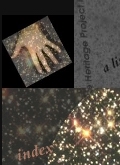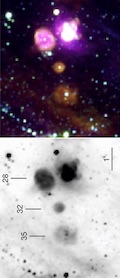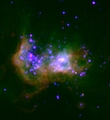



Galactic Porosity and a Star-Formation Threshold for the Escape of Ionising Radiation from Galaxies
C.J. Clarke & M.S. OeyThe spatial distribution of star formation within galaxies strongly affects the resulting feedback processes. Previous work has considered the case of a single, concentrated nuclear starburst, and also that of distributed single supernovae (SNe). Here, we consider ISM structuring by SNe originating in spatially distributed clusters having a cluster membership spectrum given by the observed HII region luminosity function. We show that in this case, the volume of HI cleared per SN is considerably greater than in either of the two cases considered hitherto. We derive a simple relationship between the "porosity" of the ISM and the star formation rate (SFR), and deduce a critical SFRcrit, at which the ISM porosity is unity. This critical value describes the case in which the SN mechanical energy output over a timescale te , is comparable with the ISM "thermal" energy contained in random motions; te is the duration of SN mechanical input per superbubble. This condition also defines a critical gas consumption timescale texh, which for a Salpeter IMF and random velocities of ~10 km s-1 is roughly 1010 years. We draw a link between porosity and the escape of ionising radiation from galaxies, arguing that high escape fractions are expected if SFR > SFRcrit. The Lyman Break Galaxies, which are presumably subject to infall on a timescale < texh , meet this criterion, as is consistent with the significant leakage of ionising photons inferred in these systems. We suggest the utility of this simple parameterisation of escape fraction in terms of SFR for semi-empirical models of galaxy formation and evolution and for modeling mechanical and chemical feedback effects. MNRAS, 337, 1299
|

